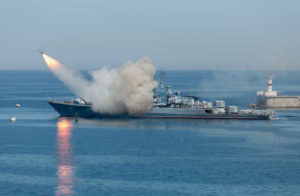Conflict Armament Research (CAR) investigators continue to dissect advanced weapon systems and communications equipment that Russia is using in Ukraine. One interesting find was that Russia reuses the same electronics (made by Western countries) across multiple weapon systems pointing to a possible bottleneck in its supply chain, reports John Ismay of The New York Times. He writes (abridged):
As Russian forces fire precision-guided weapons at military and civilian targets in Ukraine, officers in Ukraine’s security service working with private analysts have collected parts of the crashed missiles to unravel their enemy’s secrets.
The weapons are top of the line in the Russian arsenal. But they contained fairly low-tech components, analysts who examined them said, including a unique but basic satellite navigation system that was also found in other captured munitions. […]
We documented parts of the SN-99 satellite navigation systems of three different Russian cruise missiles: the 3M14, the Kh-59, and the Kh-101 2/19 pic.twitter.com/sOPMmgBylR
— Damien Spleeters (@damspleet) September 4, 2022
“We saw that Russia reuses the same electronic components across multiple weapons, including their newest cruise missiles and attack helicopters, and we didn’t expect to see that,” said Damien Spleeters, an investigator for the group who contributed to the report. “Russian guided weapons are full of non-Russian technology and components, and most of the computer chips we documented were made by Western countries after 2014.”
How Russia obtained these parts is unclear. Mr. Spleeters is asking the manufacturers of the semiconductors how their goods ended up in Russian weapons, whether through legitimate transactions or straw-man purchases set up to skirt the sanctions.
The investigators analyzed the remains of three types of Russian cruise missiles — including Moscow’s newest and most advanced model, the Kh-101 — and its newest guided rocket, the Tornado-S. All of them contained identical components marked SN-99 that on close inspection, the team said, proved to be satellite navigation receivers that are critical for the missiles’ operation.
Mr. Spleeters said that Russia’s use of the same components pointed to bottlenecks in its supply chain and that restricting the supply of SN-99 components would slow Moscow’s ability to replenish its diminishing stockpile of guided weapons.
The following two tabs change content below.
Steve Schneider
Steve Schneider is a weapons specialist for Yoursurvivalguy.com. He is our website and graphic design specialist for Youngsworldmoneyforcast.com, Richardcyoung.com, Younginvestments.com, and Youngresearch.com. Steve customizes and creates all of the images on our websites.
Latest posts by Steve Schneider (see all)
- New Chinese Electromagnetic Surveillance Leaves “Nowhere to Hide” on Battlefield - March 15, 2024
- Amazon’s Nuclear Powered Data Center - March 7, 2024
- Skunk Works Rolls Out An Engineering Marvel - March 6, 2024
- Future of Airpower Takes First Flight - March 4, 2024
- A War Beneath the Waves – Trillions of Dollars at Stake - February 9, 2024
















